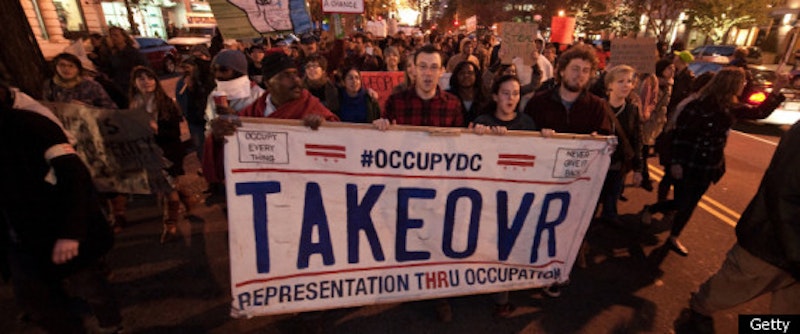It was about midnight on a cold Saturday night and I was standing in a port-o-potty in McPherson Square, the home base of the Occupy DC movement, watching urine and feces overflow onto my sneakers. A friend and I had paid a visit to the campground late that night, partially out of curiosity, but mostly with an agenda to speak to as many people as we could to try to make sense of the movement as a whole through this small microcosm in downtown Washington. By the time we left around three in the morning, we didn't have any major answers or revelations, just a faint sense of the very raw emotion and frustration that seemed to dominate the discourse of this protest.
We quickly met and befriended a small group of protesters who had traveled into D.C. from Columbus, Ohio to participate in the march that was scheduled for the following afternoon. There were a few students among the group, a rover who had been living out of his van for the past few months, a politically-charged mother of two children, and a very large and verbose man whom I later learned was the group's protector when he casually pulled a knife from his pocket and laid it on the floor of their tent to ward off a drunk intruder.
After my friend and I had made a bit of small talk, we began asking questions. Why were they here? Where is the movement going? What will happen to the movement when winter comes? We heard lamentations over student loans and unemployment, mingled in with the expected anti-corporate rhetoric that the media has accurately used to label the movement. Personal stories mixed with political diatribes in a flurry of soapbox speeches that did more to convey the deep frustration of the movement than it did to canonize any semblance of an ideology or political direction. When the questions led inevitably to “What about winter?” all we got was a half-hearted belief that they would keep fighting on.
It was getting colder when we left McPherson Square and we both agreed that it wasn't looking good for the protestors. Biology trumps ideology, no matter how steadfast, and when it gets cold, people get sick. Their bathroom facilities were overflowing, leaving chemical pools of sewage for them to walk through and track into their tents. Their only medical facility (from what I could see) was a makeshift tent with a scale and a first-aid kit. The camp was brimming with the city's homeless, taking advantage of the possibility of scrounging some spare change or a friendly meal. If things stayed the way they were going, the movement would have likely faded out by December.
Then November 15 happened. The charge led by New York City mayor Michael Bloomberg to dissipate the Zuccotti Park protestors did more to strengthen the movement than it did to destroy it. By driving the protestors out of the park, it forced them to mobilize in the streets. When police officers destroyed the Occupy Wall Street library, Jesse La Greca (arguably one of the most influential of the OWS protestors) started “Occupy Educated,” an online library to spread information on the movement and literature that supported its ethos. Time magazine launched a live video feed through Ustream that featured Tim Pool, a young documentarian covering the response for over 18 hours through the lens of a smart phone. When the protestors returned to the re-opened Zuccotti Park, it appeared that they had doubled in size (onsite sources estimated between 1500 and 4000 in attendance).
Through his coverage, Pool managed to run into Jesse La Greca, who had achieved Internet fame after out-debating Fox News's Griff Jenkins in an interview that Fox chose not to air (and was later picked up by various other publications). In his interview, La Greca claimed that the movement was entering “Phase Two” and would no longer be limited to the tents. He spoke about getting involved with other organizations and bringing their argument to a national debate, directly challenging those who disagreed with them through discussion rather than protest. The movement seems to finally be organizing.
I watched the live stream of the OWS response off and on through most of the day, and when I left work I returned to McPherson Square to see what I could of the march that was emerging in support of the Zuccotti Park protestors. As I watched from the edge of the park and listened to the “Mic Check” mass communication the protestors have adopted, I noticed that the fringe of the crowd was mostly journalists, ranging from more professional types (such as a writer in a Spin magazine jacket) to more amateur commentators, filming live feeds from smart phones or makeshift camera sets consisting of baby carriages, microphones and laptops.
I asked the owner of one of these sets how many people he estimated were part of the Occupy DC movement. He said the movement had about 200 steady supporters, living in the tents, with another 150-200 who usually showed up after five o'clock.
As the movement progresses into “Phase Two” I think these “nights and weekends activists” will end up being essential to its success. While many inevitably receive their paychecks and health benefits from the 1% that the movement is fighting against, they obviously agree with the protestors in the belief that the system they are a part of is flawed. These are the staffers who can relay the ideals of the movement to Congressmen. They're the media professionals who can help push a debate or a political rally to the forefront of their organization's agenda. Mob protest started the movement and brought it to national attention, but as it evolves, it's going to need to infiltrate deeper into the institutions that allow for decisions to be made and discussions to be had if it is going to maintain its momentum.

